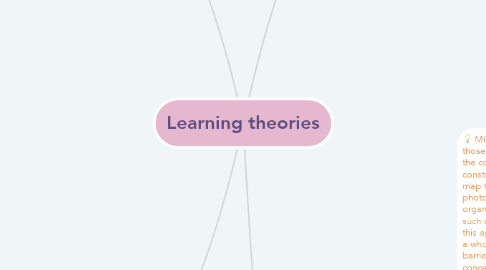
1. Cognitivism
1.1. Definition
1.1.1. Cognitive learning is a change in knowledge attributable to experience (Mayer 2011). It focuses on mental processes
1.1.2. the mind as a reference tool to the real world
1.1.3. focuses on “how information is received, organized, stored, and retrieved by the mind” helping learners to organizing relate new information to existing knowledge in memory.
1.2. Example
1.2.1. Mind maps are used to organise ideas/concepts that students need to learn.Compare and contrast matrix/chart are used to connect concepts.Through scaffolding, educators can systematically develop students' knowledge.
1.2.2. Before teachers introduce a new concept for students, they give students warm-up activities to guide students comprehending better. Also after teaching, teachers tell students some methods like using mnemonic device to help students form a long-term memory.
1.2.3. Teachers put some fundamental knowledge that students have known in order to refer to new knowledge.
1.3. Influence(s)
1.3.1. Teachers would need to spend effort to decide the most appropriate activities/tools during lesson planning. In this connection, teachers would also need to spend time on preparing the related teaching materials for students.
1.3.2. According to human's information-process components, cognitivism theory is conducive to help students perceive, understand, and retrieve knowledges. Then, when students need to solve problems, they can use these knowledge stored in their brain.
2. Constructivism
2.1. Definition
2.1.1. psychological & philosophical perspective contendingthe nature of learning
2.2. Example(s)
2.2.1. creating appropriate learning environments
2.2.2. 1.The use of cooperative learning groups.2.Conducting lesson outside of the classroom to let learner face directly the society.3.As students feel pessimistic and boring in traditional text-based teaching mode, teachers can hold some collaborative work for students to discuss their ideas based on their own experience for constructing and applying what they learn.For example, experiment activities are arranged during sciences classes. 4. Teachers change their pedagogical method to .
2.3. Influence(s)
2.3.1. Students will be active in self-centred learning based on their experience. They can use these knowledge into real lives for having a better life.
2.3.2. Teachers would need to incorporate certain experiment activities during their lesson planning. This would be a great challenge for teachers, in particular those in secondary schools, given the already tight teaching schedule.
3. Behaviorism
3.1. Definition
3.1.1. Learning as shaping behaviour.The goal of instruction is to elicit the desired response from the learner who is presented with a target stimulus.
3.2. Example(s)
3.2.1. Positive reinforcement: 1.Companies promote high performing employees to higher positions. 2.Students who get 7 score and onward on assignments will be given a badge. Parents give candies to their kids when they are well-behaved. 3.Reward / Incentive - A word of praise when students perform well. Reward / Incentive - Give students rewards for completing their homework.
3.2.2. Punishment - Students who arrive late to school will receive a warning. Three warnings would result in a them receiving a demerit.
3.2.3. A positive punishment- Students who plagiarize (behavior) in his/her study in university. Students who plagiarize usually receive a fail grade from teachers. In more serious cases, they will be liable to disciplinary action (aversive stimulus).
3.3. Influence(s)
3.3.1. 1. A structured behaviorist approach in designing multimedia tool can lead to rapid acquisition of basic concepts, skills and factual information within a clear framework. (Atkins, 1993)
3.3.2. 2. There are no opportunity for reflection and intervention on the part of the student that deviated from the prescribed learning tracks. (Ravenscroft, 2003)
3.4. Experiments
3.4.1. Pavlov's 'Dog Salivation Experiment', in which a dog salivates at the sound of a bell (McLeod, 2013).
3.4.2. Skinner's 'Skinner Box', in which a rat learns to press a lever in order to obtain food (McLeod, 2015).

